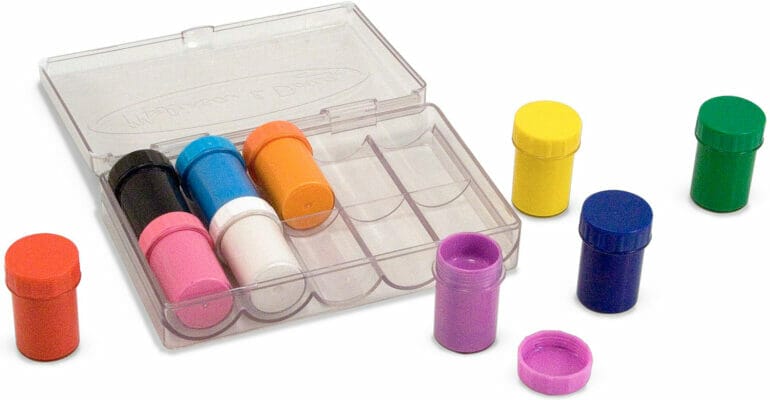Are you looking for a safe way to paint your face for a fun and creative look? Look no further than poster paint! Poster paint is a non-toxic and water-based paint that is commonly used for art projects, including face painting. It is safe to use on your skin, but it is important to make sure you are using high-quality poster paint that is specifically labeled as safe for face painting. Always do a patch test before applying it to your entire face to ensure no irritation or allergic reactions occur.

Potential Risks and Precautions of Using Poster Paint on the Face
Using poster paint on the face can be a fun and creative way to express oneself, especially during events like Halloween or costume parties. However, it is important to be aware of the potential risks and take necessary precautions to ensure the safety of your skin. In this section, we will explore the possible risks associated with using poster paint on the face and discuss the precautions that should be taken.
Possible Risks
While poster paint is generally considered safe for use on paper or other surfaces, it may not be suitable for application on the delicate skin of the face. Here are some potential risks you should be aware of:
- Skin Irritation: The chemicals present in poster paints, such as pigments and binders, can cause irritation or allergic reactions on the skin. This may manifest as redness, itching, or a rash. Certain colors or ingredients may be more likely to cause a reaction, so it is important to be cautious.
- Toxicity: Some poster paints may contain toxic substances that can be harmful if ingested or absorbed through the skin. These paints may contain heavy metals like lead or cadmium, which can have serious health effects. Using such paints on the face can be particularly risky, as accidental ingestion or contact with the eyes may occur.
- Clogging of Pores: Poster paint is not designed for use on the face and may clog the pores, leading to breakouts or acne. If left on for an extended period, the paint can also dry out the skin, causing it to become flaky or rough.
- Difficulty in Removal: Some poster paints may be challenging to remove from the skin, especially if they are oil-based or contain strong pigments. Vigorous scrubbing or using harsh cleansers can further irritate the skin.
Precautions to Take
To minimize the potential risks associated with using poster paint on the face, it is essential to take certain precautions:
- Choose Non-Toxic Paint: Look for poster paints that are labeled as non-toxic and safe for use on the skin. These paints are often water-based and do not contain harmful substances. Avoid using paints meant for other purposes, such as acrylic or oil paints, as these can be more toxic and damaging to the skin.
- Perform a Patch Test: Before applying the paint to your entire face, perform a patch test on a small area of skin. Apply a small amount of paint and wait for 24 hours to check for any adverse reactions or skin sensitivities.
- Keep Away from Eyes and Mouth: Avoid applying paint too close to the eyes or mouth, as accidental ingestion or contact can be harmful. Use a separate, non-toxic face paint specifically designed for these areas if needed.
- Protect with a Barrier: Consider applying a thin layer of moisturizer or a water-based primer on the face before using poster paint. This can create a barrier between the paint and your skin, providing some protection.
- Limit Duration of Use: Try to minimize the amount of time the paint is left on the face. Remove it as soon as the event or activity is over. Prolonged exposure to poster paint can increase the risk of skin irritation or clogged pores.
- Use Gentle Removal Methods: When removing the paint, be gentle with your skin. Use a mild cleanser or baby wipes to carefully wipe away the paint. Avoid excessive rubbing or scraping, as this can damage the skin.
In summary, while using poster paint on the face can be a fun and creative activity, it is important to be aware of the potential risks involved. By choosing non-toxic paints, performing patch tests, and taking necessary precautions, you can minimize the chances of skin irritation or other adverse effects. Remember to prioritize the safety and well-being of your skin when experimenting with face paint.

Alternatives to Poster Paint for Face Painting
Face painting is a popular form of artistic expression that is enjoyed by people of all ages. Whether it’s for a birthday party, Halloween costume, or school event, face painting adds a touch of fun and creativity to any occasion. While poster paint is commonly used for face painting, there are alternative options that can provide equally vibrant and safe results. In this section, we will explore some of the alternatives to poster paint for face painting.
1. Water-based Face Paint
Water-based face paint is a versatile alternative to poster paint for face painting. It is specially formulated to be safe and gentle on the skin, making it suitable for all ages. This type of face paint is available in a wide range of colors and can be easily mixed to create custom shades. It dries quickly, allowing you to layer colors and create intricate designs. Water-based face paint is also easy to remove with soap and water, making it convenient for both the artist and the person being painted.
2. Cosmetic Grade Face Paint
If you’re looking for a professional-grade alternative to poster paint, cosmetic grade face paint is an excellent option. This type of face paint is specifically designed for use on the skin and meets stringent safety and quality standards. It is available in a wide range of colors and finishes, including matte, metallic, and glitter. Cosmetic grade face paint is known for its long-lasting and smudge-proof formula, making it ideal for events that require all-day wear. It can be easily removed with makeup remover or baby wipes.
3. Liquid Latex Body Paint
For those who want to take their face painting to the next level, liquid latex body paint is a great alternative to poster paint. This type of paint is commonly used in special effects makeup and allows you to create realistic textures and special effects. Liquid latex body paint dries quickly and forms a flexible layer on the skin, making it comfortable to wear for extended periods. It is available in a variety of colors and can be applied using brushes or sponges. It can also be easily removed by peeling it off the skin.
4. Face Crayons
Face crayons are a convenient and mess-free alternative to poster paint for face painting. They come in the form of large, chunky crayons that can be easily applied to the skin. Face crayons are available in a variety of vibrant colors and can be used to create bold designs or fine details. They are especially popular for quick face painting at events or parties where time and precision are key. Face crayons can be easily removed with soap and water or makeup remover.
5. Airbrush Face Paint
Airbrush face paint is a high-quality alternative to poster paint that delivers professional-looking results. It involves using an airbrush machine to spray a fine mist of paint onto the skin, allowing for precise and detailed designs. Airbrush face paint is highly pigmented and provides a smooth and even finish. It is ideal for creating intricate designs, shading, and blending colors. This type of face paint is long-lasting and resistant to smudging. It can be removed with soap and water or makeup remover.
In summary, while poster paint is commonly used for face painting, there are plenty of alternatives available that offer vibrant colors, safety, and ease of use. Water-based face paint, cosmetic grade face paint, liquid latex body paint, face crayons, and airbrush face paint are just a few options to consider. Each alternative has its own unique qualities and benefits, allowing you to explore different techniques and create stunning face painting designs.

Tips for Safe Face Painting with Poster Paint
Face painting is a popular activity that adds excitement and fun to parties, festivals, and events. Using poster paint for face painting can be a great option as it offers vibrant colors and is easily accessible. However, it is important to ensure the safety of the individuals getting their faces painted. Here are some tips to ensure safe face painting with poster paint:
1. Choose Non-Toxic Poster Paint
When selecting poster paint for face painting, make sure to choose non-toxic paint that is specifically labeled as safe for use on the skin. Non-toxic paints are formulated to be gentle and free from harmful chemicals that can cause skin irritation or allergic reactions.
2. Test for Allergies
Before applying the poster paint to the face, perform a patch test to check for any potential allergic reactions. Apply a small amount of the paint to a small area on the inner arm and wait for at least 30 minutes. If any redness, itching, or irritation occurs, do not proceed with face painting using that paint.
3. Clean and Prep the Face
Prior to face painting, ensure that the face is clean and free from any dirt, oil, or makeup. Gently wash the face with a mild cleanser and pat it dry. This will help the paint adhere better and prevent any unwanted reactions.
4. Use a Paintbrush or Sponge
Instead of applying the paint directly from the container, use a clean paintbrush or sponge for better control and precision. This will minimize the risk of accidental contact with the eyes, mouth, or nose, which can lead to discomfort or ingestion of the paint.
5. Avoid Painting Open Wounds or Broken Skin
It is important to avoid painting on open wounds, cuts, or broken skin. This can introduce bacteria or irritants to the affected area and potentially cause infection or further skin damage. Be mindful of any existing skin conditions or sensitivities.
6. Remove the Paint Properly
After the face painting session, make sure to remove the paint thoroughly using a gentle cleanser or face wash. Avoid scrubbing vigorously, as this can irritate the skin. It is advisable to use makeup remover wipes or a mild oil-based cleanser to effectively remove the paint without leaving residue.
7. Provide Adequate Ventilation
If you are hosting an event or party where face painting is taking place, ensure that there is adequate ventilation in the area. This will help minimize the inhalation of any fumes or particles from the poster paint, ensuring the safety of both the face painter and the individual getting their face painted.
8. Supervise Children
If children are involved in the face painting activity, it is essential to have adult supervision throughout the process. This will help ensure that the paint is applied safely, and prevent accidental ingestion or contact with sensitive areas.
9. Discontinue Use if Irritation Occurs
If any irritation, redness, or discomfort occurs during or after face painting, it is important to discontinue use immediately. Promptly wash off the paint and consult a medical professional if necessary.
In summary, safe face painting with poster paint involves choosing non-toxic paint, conducting patch tests for allergies, preparing the face properly, using appropriate tools, avoiding open wounds, removing the paint properly, providing ventilation, supervising children, and discontinuing use if any irritation occurs. By following these tips, you can ensure a fun and safe face painting experience for everyone involved.
Removing Poster Paint from the Face: Best Practices and Recommendations
Whether you’re involved in an arts and crafts project or preparing for a Halloween costume, it’s not uncommon to find yourself with poster paint on your face. While poster paint is designed to be washable, it can be quite stubborn and challenging to remove from the skin, especially the delicate facial area.
In this section, we will explore the best practices and recommendations for safely and effectively removing poster paint from the face. We will discuss different methods and techniques that you can use to ensure a clean and paint-free complexion.
1. Preparatory Steps
Before diving into the removal process, it’s important to take a few preparatory steps to minimize any potential skin irritation and make the cleaning process easier:
- Gently wipe off any excess paint with a damp cloth or tissue. Avoid rubbing the paint as it may spread further.
- Protect your hair by tying it back or covering it with a shower cap or towel.
- Make sure to wash your hands thoroughly before touching your face to prevent dirt and bacteria from transferring.
2. Method #1: Warm Water and Mild Soap
The first method to try when removing poster paint from the face is using warm water and mild soap:
- Fill a basin or sink with warm water.
- Gently wet your face with the warm water, paying special attention to the areas with paint.
- Take a mild facial cleanser or soap and work it into a lather in your hands.
- Apply the lathered soap to your face, focusing on the painted areas.
- Gently massage your face in circular motions for a few minutes to loosen the paint.
- Rinse your face thoroughly with warm water, ensuring that all the soap and paint are completely washed off.
- Pat your face dry with a clean towel.
3. Method #2: Oil-based Cleanser
If the poster paint is particularly stubborn, you may need to use an oil-based cleanser to break down the paint:
- Choose an oil-based cleanser that is suitable for your skin type.
- Apply a small amount of the cleanser to a cotton pad or ball.
- Gently dab the cotton pad/ball onto the painted areas, allowing the cleanser to penetrate the paint.
- Leave the cleanser on for a few minutes to dissolve the paint.
- Gently wipe away the paint with the cotton pad/ball, using gentle strokes.
- Rinse your face with warm water to remove any residue.
- Follow up with a gentle facial cleanser to remove any remaining traces of the oil-based cleanser.
4. Method #3: Petroleum Jelly
If all else fails, you can try using petroleum jelly to remove stubborn poster paint:
- Dab a small amount of petroleum jelly onto the painted areas.
- Gently massage the petroleum jelly into the paint.
- Leave it on for a few minutes to soften the paint.
- Take a clean cloth or tissue and gently wipe away the paint.
- Rinse your face with warm water to remove any residue.
- Wash your face with a mild cleanser to ensure all the petroleum jelly is removed.
5. Aftercare and Skincare
Once you have successfully removed the poster paint from your face, it’s important to follow up with proper aftercare and skincare:
- Apply a gentle moisturizer to replenish any lost hydration.
- If your skin feels irritated, apply a soothing cream or aloe vera gel.
- Avoid using any harsh exfoliants or scrubs for a few days to allow your skin to recover.
- Continue with your regular skincare routine to maintain a healthy complexion.
Removing poster paint from the face can be a challenging task, but by following these best practices and recommendations, you can ensure a clean and paint-free finish. Remember to be gentle with your skin and choose the method that suits your skin type and the severity of the paint stains.FAQs
Is poster paint safe for face?
No, poster paint is not safe for application on the face. It contains chemicals that may cause skin irritation, allergic reactions, or other adverse effects. It is recommended to use face paint specifically designed for use on the skin, as it is formulated to be non-toxic and safe.
Conclusion:
In conclusion, when it comes to using poster paint on your face, it is important to exercise caution. While poster paint may be safe for some individuals, it can contain ingredients that may cause skin irritation or allergic reactions in others. It is recommended to opt for face paints specifically designed for use on the skin, as they are formulated with non-toxic and skin-safe ingredients.
Additionally, always perform a patch test before applying any paint to your face and remove it immediately if you experience any discomfort or adverse reactions. Prioritizing your safety and well-being is crucial when it comes to face painting, so make sure to choose products that are specifically intended for use on the skin.
